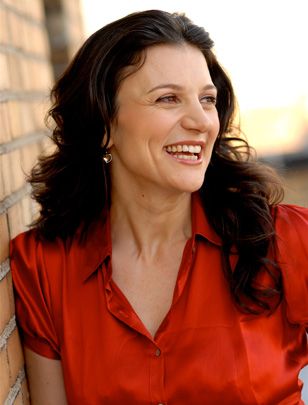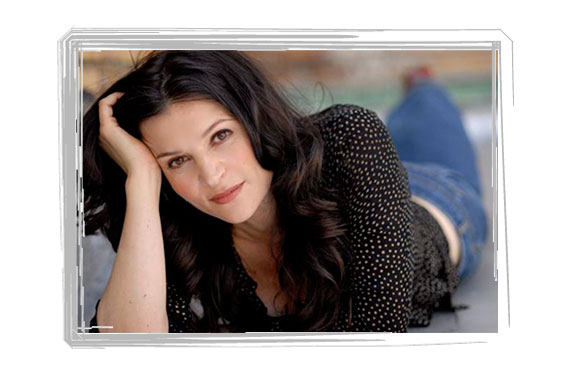When Italian-American Theater Becomes Universal
When Italian-American Theater Becomes Universal
(April 10, 2008)
When Italian-American theater becomes universal: the exquisite monologue by Antoinette LaVecchia on the relationship between an Italian mother and her Americanized daughter as well as the spectacular play THE SWEEPERS by John Picardi. Since the actress is performing again her show this coming Fall, we are republishing the interview we had with her in 2007, when she first presented it to the public
Whoever is expecting to see a regular play about the relationship between a mother and daughter, even according to the gap between cultures and generations, will be amazed. Even from the opening seconds of the monologue, you can tell that the woman standing in the middle of the stage wants to give all of herself to her audience.
She is engaged, excited, unpredictable, and even melancholic at times, but she is always full of subtle irony. In this piece, the Italian-American actress and writer, Antoinette LaVecchia, relates the lack of communication between an Italian-American mother and her Americanized daughter while showing their diverse levels of communication.
Mother-daughter relationships are often confusing and commanding, as well as distant yet close thanks to a mysterious chain of conflict and harmony. Every minute of this show, even its most hilarious moments, hides a nagging desire for understanding.

At the beginning of the show, we find Antoinette describing her birth. The psychoanalyst Carl Gustav Jung once said that every woman contains her own mother and her own daughter within her inner self. The irreverent, instinctive, and, at times, profane gestures that the actress uses to simulate her birth question us about the mystery of this blessed event. The audience is not just watching a birth; Antoinette, in her movements and through her voice, allows us to enter the uterus of her mother while she is giving birth. We watch and live the first moments of the newborn who is about to make her initial contact with the outside world and who literally has to detach herself from her mother's umbilical cord. We follow Antoinette until the moment of her "birth". At the same time, we watch the contractions, the pain, and the fear of her mother; we also hear her internal cry of "Go back inside". The act of b! irth is there in front of our eyes in its purest and crudest form.
From this point on, mother and daughter confront their own unique identities by following a path that constantly shifts between moments of attraction and repulsion. The entire monologue is a brilliantly improvised crescendo during which the Italian-American experience transcends ethnic boundaries and assumed universal characteristics.
that constantly shifts between moments of attraction and repulsion. The entire monologue is a brilliantly improvised crescendo during which the Italian-American experience transcends ethnic boundaries and assumed universal characteristics.
An instinctive actress: Antoinette LaVecchia tells us about her autobiographical monologue IN SPITE OF MYSELF.
"My mother hasn't seen it yet... Even non Italian-American women will see themselves in it..."
There is irony and anger but also tenderness, distance, and reflection: two women tell their life stories in an unsuspecting show of similarities. The crucial moments of family life are relived across a series of flashbacks and therapeutic self-evaluation where the mother figure is often found to be at fault, "There's a monster under my bed! I can't sleep! Mom, can I sleep with you?" "Pray to the Blessed Virgin... You be fine!" It is easy to set aside this faithfulness lived through superstition and devotion, resignation and defense, and justification of the existence of God to understand this Italian-American working mother who immigrated to the United States from Southern Italy and the rebellion of her daughter. "Figlia mia, do you go to church? No?! If you don't go to church that means you do! n't believe in God. You'll have bad luck. Do you take an image of Padre Pio with you wherever you go?... My daughter is divorced! Good people don't do those kinds of things! Once you get married you're stuck for life. Why do people always need to be so happy?"
This sense of constant guilt where it seems obligatory to feel condemned to a certain lifestyle clashes with the daughter's determination to control her own destiny. She believes in God but she doesn't go to church. She sells her wedding gown to a second-hand clothing store and she is divorced. She wants to be an actress. Because she is tormented by the constant uninvited phone calls from her mother, she looks for satisfaction not just as a daughter but also as a woman.
The mother-daughter voices are striking; they look for each other, even if they don't always understand each other. The levels of communication between them are contradictory but the y frantically attempt to meet each other at times so they could find a possible compromise. For example, the mother insists on sewing curtains for her daughter but she wants nothing to do with them at first. Eventually the daughter gives in; she will have curtains on her window (a symbol of her mother's skill as a parent "There can't be windows without curtains!"). But, the daughter's curtains will not be decorated with purple lines and polka dots. They will be white...
y frantically attempt to meet each other at times so they could find a possible compromise. For example, the mother insists on sewing curtains for her daughter but she wants nothing to do with them at first. Eventually the daughter gives in; she will have curtains on her window (a symbol of her mother's skill as a parent "There can't be windows without curtains!"). But, the daughter's curtains will not be decorated with purple lines and polka dots. They will be white...
We met the writer-actress at the end of her performance. From the second she opened her mouth, it was easy to understand that her involvement in this show is not only professional but also personal.
"My mother has never seen this show, she might see it sometime next week. I am a little nervous but I think it will do her good to see it. I am very sure that my way of life, especially my divorce, has made her reflect on her own lifestyle and, as a result, she has become more independent as a person. She is now 57 years old and thanks to her interactions with other people, she is getting stronger. It took her 10 years to learn English and she lived an isolated life which she devoted to the needs of her family."
Antoinette, tell us a little bit about yourself and how you were able to write this very personal piece.
"My family is originally from Salerno; we came to America when I was 3 years old. My mother worked but was very much a loner. This show really helped me to understand her as well as to overcome the sense of oppression that II felt because of her constant attempts to control my life. She wanted me to be more like her but she couldn_t communicate with me: we didn't speak the same language. Thanks to this show, I have been able to understand her as well as find her. I rediscovered her story, her origins; I think I have understood why she always wants to control meit is an attempt to communicate..."
When did you write this monologue?
"I didn't really write it. In Spite Of Myself is a work in progress, much like my relationship with my mother. It is not a scripted piece; it is improvisation."
The story that you portray is found within the Italian-American culture. Do you think the message it contains goes beyond cultural boundaries?
"Certainly. The mother-daughter relationship that I describe has a universal appeal. Many women have seen themselves in what they have seen on stage and they were not Italian-American."
How do you think that women in American cinema and theater are portrayed?
"They are often portrayed badly. The representations are not true to life: the female voice has not yet been heard as it deserves to he."
Let's use a modern example, what do you think of the character of Carmela Soprano?
"I like her strength, there are women out there who are like that. But the character herself is exaggerated: she is too masculine. Also, the representation of the Mafia is overdone and unrealistic. There is too much fiction..."
Do you have any projects for the future?
"I would like to talk more about families and relationships. I enjoy acting; I am an actressbut this experience of being a writer has been amazing."
Is there an actress that influences your work?
"Without a doubt Anna Magani. She has a very instinctive acting style."
It is true, the most striking part of In Spite Of Myself is Antoinette's use of her body and of her voice as well as the added pauses: Antoinette, the woman, is visceral, precise, and motherly. The image of the solitary actress at the middle of the stage that reminds us so much of the middle of a mother's womb will most assuredly remain engraved in your minds after having seen this performance.

(In Spite of Myself)
Directed by Ted Sod
@
Cherry Lane Studio Theatre
38 Commerce Street (Off 7th Avenue, 1 block south of Bleecker)
New York NY 10014
To buy tickets, call
Telecharge
(212-239-6200 or 800-432-7250)
or
Visit their website
Related Links
This work may not be reproduced, in whole or in part, without prior written permission.
Questo lavoro non può essere riprodotto, in tutto o in parte, senza permesso scritto.



